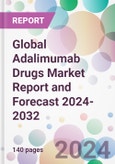Global Adalimumab Drugs Market Outlook
The global adalimumab drugs market size is anticipated to grow at a CAGR of 5.1% during the forecast period of 2024-2032, driven by entry of biosimilar versions of adalimumab into the market across the globe.Adalimumab: Introduction
Adalimumab is a biologic medication used to treat a variety of autoimmune diseases by targeting and inhibiting tumor necrosis factor (TNF), a substance in the body that causes inflammation. It is commonly used to treat conditions such as rheumatoid arthritis, psoriatic arthritis, ankylosing spondylitis, Crohn's disease, ulcerative colitis, and plaque psoriasis. Administered via injection, adalimumab helps reduce inflammation, relieve symptoms, and prevent disease progression. It is a crucial option for patients who have not responded to traditional treatments.Key Trends in the Global Adalimumab Drugs Market
The entry of biosimilar versions of adalimumab into the market is a significant trend, especially as the patent for the original brand-name drug, Humira, has expired in many regions. This has led to increased competition, offering more affordable treatment options for patients and influencing pricing and market dynamics across regions.Continuous research and clinical trials have expanded adalimumab's approved indications to include a broader range of autoimmune diseases. This expansion has driven its usage in new patient populations, contributing to the growth of its market presence.
There's a growing trend towards personalized medicine in the adalimumab drugs market, with efforts to identify biomarkers that predict patient response to the medication. This approach aims to optimize treatment outcomes and reduce unnecessary exposure to the drug for non-responders, enhancing overall patient care.
Pharmaceutical companies are engaging in strategic collaborations and partnerships to enhance the development and distribution of adalimumab biosimilars. These collaborations aim to leverage manufacturing capabilities, regulatory expertise, and market access, facilitating the global availability of biosimilars.
Manufacturers of adalimumab and its biosimilars are increasingly focusing on patient support programs to improve treatment adherence and patient outcomes. These programs offer financial assistance, educational resources, and injection training, which are critical for maintaining long-term therapy with injectable biologics.
The regulatory landscape for biosimilars is evolving, with agencies in North America, Europe, and other regions establishing clearer pathways for biosimilar approval. This trend is crucial for ensuring the safety, efficacy, and interchangeability of biosimilars with their reference products, influencing market acceptance and growth.
Global Adalimumab Drugs Market Segmentation
Market Breakup by Indication
- Rheumatoid Arthritis
- Psoriatic Arthritis
- Ankylosing Spondylitis
- Chronic Plaque Psoriasis
- Crohn's Disease
- Ulcerative Colitis
- Others
Market Breakup by Type
- Biologics
- Biosimilars
Market Breakup by Route of Administration
- Oral
- Parenteral
- Others
Market Breakup by Age Group
- Pediatric
- Adult
- Geriatric
Market Breakup by Distribution Channel
- Hospitals
- Specialty Clinics
- Homecare
- Others
Market Breakup by Region
- North America
- Europe
- Asia Pacific
- Latin America
- Middle East and Africa
Global Adalimumab Drugs Market Overview
In North America, the adalimumab market is mature, with a strong emphasis on treating autoimmune diseases. The region has witnessed a significant adoption of biosimilars following the expiration of patent protections, increasing competition and accessibility. There's a focus on personalized medicine to tailor treatments to individual patient needs, supported by advanced healthcare infrastructure and comprehensive insurance coverage.Europe's market has seen a rapid increase in the adoption of adalimumab biosimilars, driven by supportive regulatory frameworks and policies promoting biosimilar use to reduce healthcare costs. The region prioritizes access to biologic therapies for patients with autoimmune diseases, with healthcare systems in various countries actively negotiating prices to enhance affordability.
The Asia-Pacific adalimumab market is growing, driven by increasing awareness of autoimmune diseases, improving healthcare infrastructure, and rising healthcare spending. The demand for biologic therapies is expanding, particularly in countries like China and India, though accessibility varies across the region. Efforts to introduce biosimilars and make treatments more affordable are key trends.
Global Adalimumab Drugs Market: Competitor Landscape
The key features of the market report include patent analysis, grants analysis, clinical trials analysis, funding and investment analysis, partnerships, and collaborations analysis by the leading key players.- F. Hoffmann-La Roche Ltd.
- Mylan N.V.
- Teva Pharmaceutical Industries Ltd.
- Sanofi
- GlaxoSmithKline plc
- Novartis AG
- Pfizer Inc. (US)
- Biogen
- Fresenius Kabi AG
- Zydus Cadila
- Boehringer Ingelheim International GmbH
- Amgen Inc.
- AbbVie Inc.
- Abbott
- CELLTRION INC.
- Samsung Bioepis
This product will be delivered within 5-7 business days.
Table of Contents
1 Preface
3 Global Adalimumab Drugs Market Overview
4 Global Adalimumab Drugs Market Landscape
5 Global Adalimumab Drugs Market Dynamics
6 Global Adalimumab Drugs Market Segmentation
7 North America Adalimumab Drugs Market
8 Europe Adalimumab Drugs Market
9 Asia Pacific Adalimumab Drugs Market
10 Latin America Adalimumab Drugs Market
11 Middle East and Africa Adalimumab Drugs Market
12 Patent Analysis
13 Grants Analysis
14 Funding Analysis
15 Partnership and Collaborations Analysis
16 Regulatory Framework
17 Supplier Landscape
18 Global Adalimumab Drugs Market - Distribution Model (Additional Insight)
20 Company Competitiveness Analysis (Additional Insight)
21 Payment Methods (Additional Insight)
Companies Mentioned
- F. Hoffmann-La Roche Ltd. Mylan N.V. Teva Pharmaceutical Industries Ltd.
- Sanofi
- GlaxoSmithKline plc Novartis AG Pfizer Inc. (US)
- Biogen
- Fresenius Kabi AG
- Zydus Cadila
- Boehringer Ingelheim International GmbH
- Amgen Inc. AbbVie Inc.
- Abbott
- CELLTRION INC.
- Samsung Bioepis
Methodology

LOADING...








